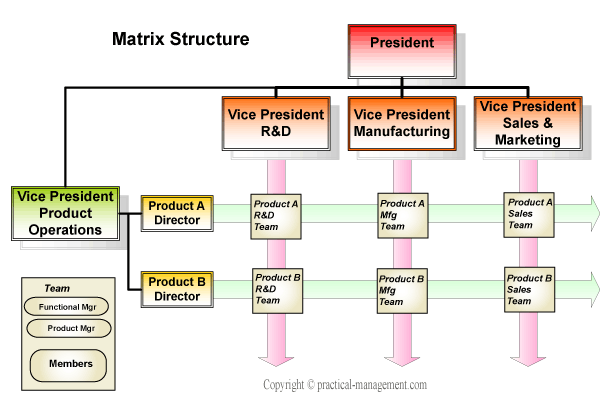Explains the Matrix structure which has both divisional and product structures and is more horizontal than either of them.
Matrix Structure
The matrix structure superimposes the product structure laterally over the functional structure (Recommended reading: functional vs. divisional structure). The result is creation of dual line of authority that is balanced by top managers. It is formulated with the desire to maximize the strengths and minimizing the weakness of the both structures.

The matrix structure has three distinctive components
- Top Manager: The top manager heads the entire matrix and balances the dual-chain of commands. He is critical to conflict management that intrinsically occurs due to dual chain of commands underneath him.
- Two matrix managers: For each matrix team or sub-group, there is one functional manager and one product manager. While functional manager’s role is to coordinate and maximize the potential of specialists across different products, the product manager’s role is to coordinate different functionalities of the owning product.
- Teams: These are the teams that directly report to the two matrix managers. Each team operates on a single product’s specialized functionality.
Strengths of Matrix structure
- Accessibility of Specialists: The functional knowledge is shared between all products, since the functional manager is responsible for technical coordination; he is able to facilitate knowledge sharing across the product lines. ‘
- Flexible team resources: The teams are fluid and the specialists can be interchanged between products, this provides better career growth and variety for the team members.
- It provides an opportunity for employees to pursue either technical or management skills based on their interest. Many employees find this motivating and very satisfying.
- It also maximizes the usage of resources since new products or changes can be incorporated quickly by moving and regrouping the teams based on the necessity.
- The organization is more adaptable to external changes since resource exchange and regrouping is encouraged and desired by both employees and the organization.
- Better intra-team communication: The presence of dual chain of command results in better communication between both functional groups across same product, and product groups within same function.
Weaknesses of Matrix Structure
- Role & Authority Ambiguity: The dual reporting lines create a lot of confusion related to management role and authority demarcation within the structure. How much control does product manager has over the functional requirements of the product? The dual authority implies that the final product needs to be agreed by both product and functional managers, if this cannot happen in a constructive manner, the cost of management defeats the benefits of the structure.
- Hard to Manage: Everyone in the matrix reports to two managers with complimentary responsibilities, proper coordination requires lot of meetings and excellent interpersonal skills. It requires a lot of effort to maintain power balance and resolve frequent conflicts that arise from role ambiguity. At the very top level, the entire matrix is managed by a single manager, if too many decisions are referred to him, he may get overloaded with the task of running the matrix.
Essential components for successful matrix
- Performance Management: Dual reporting lines results in tracking of individual’s performance by two bosses instead of one, the bosses also own very different areas, product vs. technical functionality. Hence, a satisfactory career growth depends upon that rating of two bosses, whether their ratings match or contradict. For an individual it’s double task of proving himself to two supervisors. If the authority of performance evaluation is given to only one boss, then the positional power of other boss reduces considerably and thereby his effectiveness. Hence the structure tends to reward the political skills of individuals rather than their core competencies and is often perceived as unfair. Designing a performance management system that continually enhance the productivity and motivation of an employee becomes very challenging, since the structure has inbuilt ambiguity and conflict.
- Conflict Management: Matrix structure requires a well articulated conflict management, clear role definitions, kind of positional power, cultural and behavioral interventions.
Conditions for Matrix
- Dual Focus: The organization’s environment or strategy must exert pressure to generate rapidly changing products that are technically sophisticated. Such dual focus advocates the need to create a matrix as a way to maximize the outcome of both product and functionality.
- Shared Resources: There must be sufficient pressure to share the technical resources across the products, the resources must be perceived as quite scarce. It can be due to various factors:
- Small to medium organization with multiple functional products.
- The required specialization is hard to obtain and duplicate.
- Strong interdependence between the technical tasks.
- Rapidly evolving core technology.
- Uncertain environment: The environment that the organization operates under is unpredictable, highly competitive and technically complex. These favorable conditions must exist to support the need for a dual focus.
